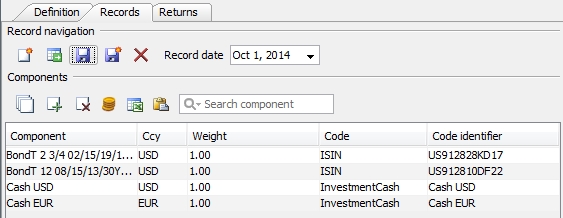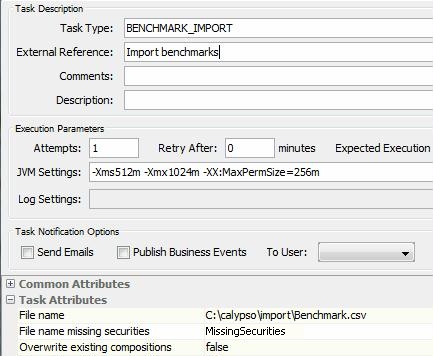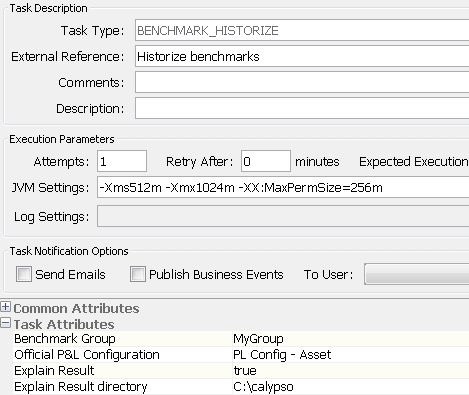Defining Benchmarks
This document describes how to create a benchmark using the Benchmark window.
A benchmark can be used as a reference to analyze portfolio performance.
1. Configuring Benchmarks
From the Calypso Navigator, navigate to Configuration > Asset Management > Benchmark (menu action am.benchmark.BenchmarkWindow) to create a benchmark.

| » | To view an existing benchmark, click |
| » | To create a new benchmark, click |
| » | Click |
Note that if the Authorization mode is enabled, an authorized user must approve your entry.
Definition Panel Details
|
Fields |
Description |
||||||||||||
|
Name |
This name identifies the benchmark throughout the system, and appears in the quote name. |
||||||||||||
|
Id |
The benchmark is given a unique identifier by the system upon saving. |
||||||||||||
|
Version |
Displays the version number of the benchmark. |
||||||||||||
|
Active |
Check if the benchmark is active, or clear otherwise. |
||||||||||||
|
Type |
Select the type of benchmark: Weight, Quantity, Notional, Market value, MarketIndex, Portfolio, Strategy, Carve out, or Top-down.
|
||||||||||||
|
Currency |
Select the currency of the benchmark. |
||||||||||||
|
Drifted |
Only applies to Weight benchmarks. If checked, the weight of the components is computed daily. Otherwise, the weight is constant between two record dates. |
||||||||||||
|
Rescaling |
If checked, the benchmark is dimensioned to the Market Value of the object to which it is compared (Fund, Strategy, or Mandate). Otherwise the benchmark has a market capitalization. |
||||||||||||
|
Liability |
This attribute is for information purposes only. |
||||||||||||
|
Valuation historized |
If checked, when benchmark valuation is required (i.e. when running Benchmark analysis), valuation history is read. If history is found, computation is skipped. If history is not found, valuation is computed and history is stored. If un-checked, valuation history is ignored. Historization is supported for the following benchmark types:
Note that although historization is not supported for the other types of benchmarks, those that are composites of the supported types will still benefit from the historization of these. The BENCHMARK_HISTORIZE scheduled task can be used to pre-compute the valuation and store the history.
|
||||||||||||
|
Holidays |
Select a holiday calendar as needed. |
||||||||||||
|
Pricing Environment |
Select a pricing environment to price the components. |
||||||||||||
|
Market Index |
Only applies to MarketIndex benchmarks. Select a market index. |
||||||||||||
|
Portfolio |
Only applies to Portfolio benchmarks. Select a portfolio. Portfolios are created using Configuration > Asset Management > Portfolio Hierarchy from the Calypso Navigator.
|
||||||||||||
|
Strategy Fund Target Level |
Only applies to Strategy benchmarks. Select a fund or a mandate. Strategies have been allocated to the fund or mandate, and the strategies may contain sub-strategies. Enter the level of the allocation in case multiple levels of allocation have been defined. Strategies are allocated to funds and mandates using Configuration > Asset Management > Portfolio Hierarchy.
|
||||||||||||
|
Allocation Indicator |
Only applies to Strategy benchmarks. Select the allocation indicator: SAA or TAA. The adjustment type for both is Weight. |
||||||||||||
|
Carve out Master Benchmark |
Only applies to Carve out benchmarks. Select a static data filter that defines a subset of a master benchmark. For example, the static data filter may filter issuers. Only static data filters defined for the group "Carve-out" are available for selection. Select the master benchmark. |
||||||||||||
|
Top-down hierarchies |
Only applies to Top-down benchmarks.
|
||||||||||||
|
Benchmark Family |
Select the benchmark family to which the benchmark belongs. Benchmark access permissions are set at the benchmark family level. You need to define the benchmark families in the domain benchmarkFamily. For example:
|
||||||||||||
|
Select the benchmark group to which the benchmark belongs. Benchmark groups allow running the BENCHMARK_HISTORIZE scheduled task on a sub-set of benchmarks.
You need to define the benchmark groups in the domain benchmarkGroup. |
|||||||||||||
|
External reference |
Enter an external reference id as applicable. |
||||||||||||
|
Country |
Select the country of the benchmark. |
||||||||||||
|
Issuer |
Select the issuer of the benchmark. The issuer is a legal entity with the Issuer role. |
||||||||||||
|
Exchange |
Select the benchmark's exchange. The exchange is a legal entity with the MarketPlace role. |
||||||||||||
|
Provider |
Select the provider of the benchmark. The provider is a legal entity with the Provider role. |
||||||||||||
|
Frequency |
Select the publish frequency. |
||||||||||||
|
Roll On day |
Some schedules have specific publishing days: Day of the week, month, etc. |
||||||||||||
|
Holidays |
Select the holiday calendars to determine the non-business days for the publication dates. |
||||||||||||
|
Hour |
Enter the hour of the day when publishing occurs. |
||||||||||||
|
Minute |
Enter the minute when publishing occurs. |
||||||||||||
|
TimeZone |
Select the timezone for the publish time. |
||||||||||||
|
Date Rule |
Select a date rule for publication dates, if any. Date rules are created using Configuration > Definitions > Date Schedule Definitions > Date Rules. |
||||||||||||
|
Comment |
Enter a free-text description as applicable. |
Records Panel Details

| » | Click |
| » | Then click |
Repeat as needed to add more components.
Adjust the weight, notional, quantity, or market value of each component as needed.
For Quantity benchmarks, adjust the inclusion factor of each component as needed. Used for MSCI indices, this multiplicative factor between 0 and 1 is used to compute weight and return.
| » | Click |
Repeat as needed to add more records.
| » | You can also click |
| » | You can click |
The cash added is then available for selection as a component of InvestmentCash product.
| » | You can click |

| » | You can copy the components from an Excel spreadsheet and click |
Returns Panel Details
The Returns panel allows computing the benchmark's value over a user-defined period.

| » | Select a start date and an end date. |
| » | Select a pricing environment. |
| » | You can select an “Official” P&L Configuration to use for benchmark returns calculation. Note that the underlying pricing env of this P&L Config must match the pricing env specified in the adjacent field. |
| » | Select a trade filter template to be used as a template for the position spec. The trades and positions are loaded based on the records, and this trade filter is only used to define the position spec. |
| » | You can click |
| » | Click |
2. Importing Benchmark Components
You can import benchmark components from a CSV file using the scheduled task BENCHMARK_IMPORT.

Task Attributes:
| • | File name – Enter the file name that contains the benchmark components. |
| • | File name missing securities – Enter a file name to store the components that are not defined in the system. |
| • | Overwrite existing compositions – Select true to override the existing components if any, or false otherwise. |
Sample File
#"Benchmark", Name, yyyy-MM-DD, Price Adjustment
#SecCode, CodeValue, Amount, InclusionFactor
#
Benchmark,SPX Benchmark,2014-08-19,1
ISIN,US0605051046,1.06E+10,1
ISIN,US0378331005,8.92E+08,1
ISIN,US3696041033,1.00E+10,1
ISIN,US1729674242,3.04E+09,1
ISIN,US4581401001,4.97E+09,1
ISIN,US5949181045,8.30E+09,1
ISIN,US30231G1022,4.32E+09,1
ISIN,US4592001014,1.04E+09,1
3. Historizing Benchmarks
You can pre-compute benchmark valuation and store the history using the scheduled task BENCHMARK_HISTORIZE. This will reduce the computation time when Benchmark analysis, or any other process which requires benchmark value, benchmark returns, or benchmark weights, is run.

Common Attributes:
| • | Pricing Environment – Select a pricing environment. |
Task Attributes:
| • | Benchmark Group – Select a benchmark group. |
| • | Official P&L Configuration – Select an “Official” P&L Configuration. |
| • | Explain Result – Select true to generate an Excel file of explained benchmark calculations, or false otherwise. |
| • | Explain Result directory – Specify the directory in which to save the Excel file. |
4. Viewing Benchmarks
You can view all available benchmarks in the Benchmark Blotter (menu action am.benchmark.BenchmarkBlotterWindow).

| » | You can filter the list of benchmarks using the search field in the upper left corner. |
| » | You can double-click a benchmark to open it in the Benchmark Window. |
 See
See 